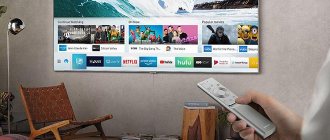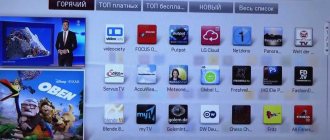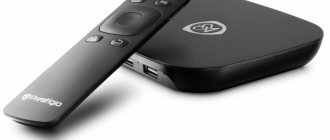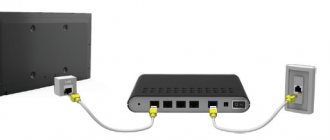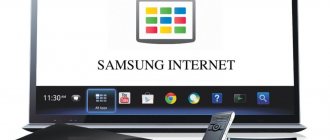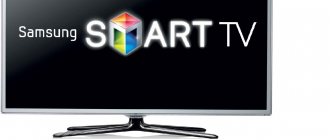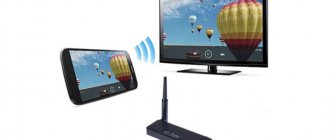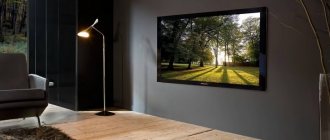What do you need to connect your TV to the Internet via cable?
To establish a wired connection, you need:
- the provider cable that comes from the entrance or from the modem in your apartment, or a LAN cable (if we connect through a router);
- TV with Smart TV and LAN connector;
- router (if a direct connection is not suitable for you);
- availability of Internet access (paid tariff);
- network type - find out from your provider what protocol it works with: call technical support or look at your contract with the company. Protocol options: PPPoE, L2TP, PPTP, dynamic IP, static IP.
Smart TV settings
After connecting, the user needs to configure the Smart TV for further use. The most popular TV receivers are devices from Samsung, LG and Sony. Setting up equipment from the first two brands is similar; devices from Sony work a little differently.
Samsung and LG
Setting up access to the Internet on LG TVs and Samsung Smart TVs is done in a similar way, but on LG equipment you will need to register.
To do this, you need to go to the smart menu and in the top right corner click on the icon to log into your account. The service will prompt you to register, after which you will need to come up with a password and login, enter your e-mail, open your e-mail and confirm registration. Next you need to log in to the system. To access the Samsung TV to the Internet, such actions are not required. Using the app store on Samsung and LG TVs looks similar. The user has access to default content, he can download new games and programs, access the Internet through a browser, etc.
Sony
To set up Smart TV on a Sony Bravia TV, you need to press the “ Home ” key on the remote control, click on the icon with a suitcase in the top right corner and find the “ Network ” section.
Here you need to click on the “ Update Internet Content ” button. After the service has been configured, the television receiver will notify you about this.
To open the list of favorite applications, you need to press the “ SEN ” button on the remote control. To access all applications, you need to select the “ + ” button. Having selected the desired utility, the user can launch it or add it to the list of favorite programs.
Pros and cons of this connection method
What good can be in a cable Internet connection in principle? Why this bunch of wires if you can use Wi-Fi? Yes, you can, but firstly, not all TVs have built-in Wi-Fi modules. If you are a fan of wireless connection, but the TV module does not have a TV module, you will have to buy it separately.
If you need to use the Internet not only on TV, but also on your PC and phone, connect your TV to the Internet using a cable through a router
Secondly, data is transferred over a wire much faster than over Wi-Fi. Almost all routers reduce speed. Plus, they have to distribute the signal to several devices at once - the signal and speed are divided between participants in the local network.
Thirdly, a cable connection is more stable than a wired one. Data transmission failures will occur less frequently.
Network cable can be connected directly to PC
The downside of this method, of course, is the number of wires. They do not always fit into the interior. Besides, it's inconvenient. If the router and TV are far from each other, even more so. You will either have to buy a long cord or move the router closer to the TV.
If you don't have a router and don't want to use it, but have a cable from your provider, you can plug the cord directly into the TV. You don't have to buy a router. If the TV is not equipped with a Wi-Fi module, a direct cable connection will be the only budget option.
Samsung
By wire
This company has an offline connection setup mode for a wired connection.
- In the main menu, click “Network” and go to “Network Settings”.
- In the “Network Type” set “Cable”, and then click “Connect”.
Via Wi-Fi
- We also go to settings, then “Network” and “Network settings”.
- Select the type “Wireless”.
- Next, the device will begin searching for connections. Click “Select network SSID ”, enter the password and click “Finish”.
- If you can't see your home grid, it may be hidden. To do this, click “Add network” and enter the name manually. You can look up your name on your smartphone if you have forgotten it.
TV cable connection diagrams
We will show and tell you how to connect a TV to a router or simply to an Internet provider cable.
Via router
If you decide that you need an intermediary in the form of a router, do the following:
- Connect the provider's cable to the WAN or Internet port (depending on the router model).
- Configure the connection on the router depending on the protocol. We have already described above what protocols there may be. The setup takes place on the local page in the browser at 192.168.1.1 or 192.168.0.1. The debugging process will depend on the router manufacturer (interfaces differ). Take a look at the instructions for your router - everything should be described in detail there.
- If the router has been connected and configured for a long time, skip the first two steps. Take the Ethernet cord that comes with the router. If it doesn't exist, or if it's too short, buy a new one at a computer store (labeled RJ-45).
- Connect the cable to the LAN port on the back of the router (choose any) - these outputs are usually yellow.
- Insert the second free end of the cord with the same plug into the LAN connector on the back of the TV. It is advisable to turn on the TV.
Using a special cord you need to connect the router to the TV
Directly
Everything is simpler here: we immediately connect the provider’s cable to the LAN port on the TV. The cable can come directly from the entrance or from the street, from a splitter (if it is a telephone ADSL connection, the splitter separates the signals for the telephone and the Internet) or from a modem (it is configured by the provider’s specialists upon connection).
Almost all modern TVs have functionality that allows them to access the Internet.
All that remains is to connect it and configure it. There are two ways to connect your TV to the Internet: 1 Using a network cable;
2 Using a wireless Wi-Fi connection.
In this article I will describe the first method in detail. The main advantage of this method is that you will have virtually no loss of Internet speed, unlike a wireless connection. This is especially important if you have low Internet speed. The downside is that you need to pull the network cable to the TV, BUT this is not at all necessary since there are technologies that allow you to transmit network packets over the power network, described in more detail in the article Internet / local home network via an outlet. HomePlug AV technology .
Connecting a cable to a TV is not as simple as it might seem at first, since you need to understand where this cable comes from and where one of its ends is connected. And here there are two options:
1 Network cable is connected to the router;
2 The network cable comes from the entrance (provider cable).
Let's look at each option in more detail.
Connecting the TV to the Internet using a network cable from your provider.
This method does not require any additional devices and initially it may seem that everything is simple, but this is not entirely true. The thing is that providers use various connection technologies, for example PPPoE, L2TP, Dynamic IP, Static IP. The settings that need to be made on the TV for the Internet to work there depend on what technology your provider uses. You can find out what technology your provider uses by looking at the contract with the provider or calling technical support. Next, I propose to analyze each of the connection technologies:
Dynamic IP . If your provider uses Dynamic IP, it requires minimal effort from you:
1 Connect the network cable from your provider to the TV;
2 Make sure your TV is using Automatic search for network settings.
As an example, I will describe how to do this on LG TVs with WebOS.
Press the "Settings" button on a regular remote control.
If you have a remote magic remote control, press the “Input” button.
Select the gear icon.
Then select Network - Wired Ethernet Connection. There you should see “Connected to the Internet”, if so, then congratulations, you have set up the Internet on your TV.
If you see the message “No Internet connection via Ethernet“, select this connection and make sure that it is set to receive network settings automatically.
Static IP . With this connection method, you need to find out your network settings from the contract with the provider and register them in the TV settings. We do everything step by step:
1 Connect the provider’s network cable to the LAN port of the TV.
2 Go to the TV settings and enter the network settings of the provider.
For example, on LG TVs, press the “Settings” button, select from the menu - “Network” - “Wired Ethernet connection”,
Next, click the “Change” button.
Uncheck “Automatically” and enter the IP address, mask, gateway, DNS issued by your provider.
PPPoE, L2TP . Unfortunately, not many TVs allow you to set up the Internet if your provider provides the Internet using PPPoE and L2TP technologies. And for most, the way out of this situation is to use a router to connect the TV to the Internet.
Setting up the Internet on the TV when connected via a router.
For this method, it is necessary that the Internet is already configured on the router (you can find out how to configure the router in other articles on our website). Connect one end of the cable to any LAN port of the router.
The other end of the cable goes into the TV.
Go to your TV settings. On LG TVs, to do this, on a regular remote control, press the “Settings” button
or the “Input” button on remote magic controls
and select the gear icon.
Go to the “Network” - “Wired Ethernet Connection” menu and make sure that “Connected to the Internet” is indicated below this inscription.
If this is not the case, check that the TV receives network settings automatically by selecting an Ethernet connection. Click the "Edit" button.
And check the “Automatic” checkbox.
Thus, without much effort, using a LAN network cable, you can set up the Internet on any TV (LG, Philips, Samsung, Sony, etc.).
Immediately after setting up the Internet, I recommend updating the firmware on the TV:
How to update the firmware on a Samsung TV.
Video of connecting the TV to the Internet using LAN, Wi-Fi.
I really hope my article helped you! Please share the link with your friends:
How to find out the MAC address of a TV
A direct connection may not work for you if your ISP uses MAC address binding. The provider has a MAC device (its physical number) to which the Internet was previously connected (your router, PC). Now you have decided to change the device, so the provider needs to inform the new MAC of your TV, so that the company now supplies the Internet to this device too.
How to find out the MAC address of the TV? This unique code is, of course, found in the TV documentation. Or you can view the address on the screen of the device itself. If you have a Samsung, go to the “Support” section, under “Product Information” there will be “Model Code”. This is the MAC of your TV.
You can find out the model code through the “Support” block
Does your TV support Wi-Fi
The Smart TV function is responsible for connecting the TV device via Wi-Fi to the Internet. This is a special integration technology that provides the TV and its owner with the maximum possible range of online functions.
You can also turn a TV receiver into an Internet device without the Smart option. But you will have to use a PC or laptop, or get a special set-top box, and also use an HDMI cable. The procedure for setting up the set-top box and step-by-step connection via a computer is described below.
If the technical documentation indicates support for Smart TV, then the television device is definitely suitable for working on the Internet. The connection can be made directly or via Wi-Fi. Please review the instruction manual carefully. Or, alternatively, find a description of your TV device on the web store website. If the device is equipped with a Smart TV, this is clearly indicated in the list of characteristics of the product unit.




